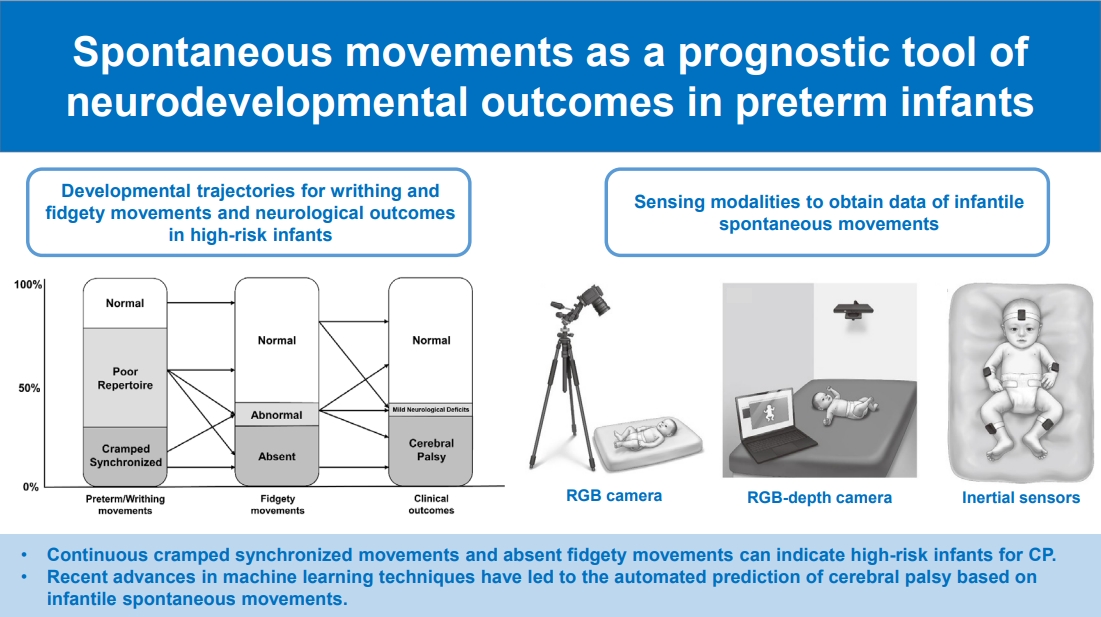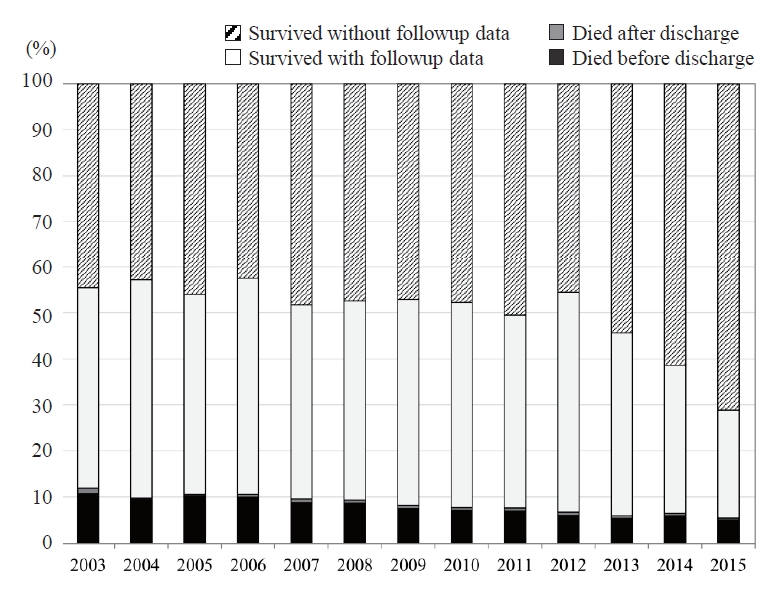Search
- Page Path
-
- HOME
- Search
- Review Article
- Developmental and Behavioral Medicine
- Spontaneous movements as prognostic tool of neurodevelopmental outcomes in preterm infants: a narrative review
- Hyun Iee Shin, Myung Woo Park, Woo Hyung Lee
- Clin Exp Pediatr. 2023;66(11):458-464. Published online May 16, 2023
-

· Spontaneous movements can be useful to evaluate neuronal integrity in preterm infants.
· In General Movements Assessment, continuous cramped synchronized movements and absent fidgety movements can indicate high-risk infants for cerebral palsy.
· Recent advances in machine learning techniques have led to the automated prediction of cerebral palsy based on infantile spontaneous movements.
- Neonatology (Perinatology)
- Neurodevelopmental outcomes of very low birth weight infants in the Neonatal Research Network of Japan: importance of neonatal intensive care unit graduate follow-up
- Yumi Kono; on behalf of the Neonatal Research Network of Japan
- Clin Exp Pediatr. 2021;64(7):313-321. Published online November 9, 2020
-

· Very low birth weight infants remain at high risk of developing neurodevelopmental impairments in early childhood.
· It is important to establish a network follow-up protocol and complete assessments with fewer dropouts to enable clarification of the outcomes of registered infants.
· All possible strategies should be employed to maintain good compliance after neonatal intensive care unit discharge.
- Original Article
- Endocrinology
- The effect of low-dose intravenous bisphosphonate treatment on osteoporosis in children with quadriplegic cerebral palsy
- Soon Jeong Moon, Young Min An, Soon Ki Kim, Young Se Kwon, Ji Eun Lee
- Clin Exp Pediatr. 2017;60(12):403-407. Published online December 22, 2017
-

Purpose Quadriplegic children with cerebral palsy are more susceptible to osteoporosis because of various risk factors that interfere with bone metabolism. Pamidronate is effective for pediatric osteoporosis, but there are no guidelines for optimal dosage or duration of treatment in quadriplegic children with osteoporosis. We aimed to evaluate the efficacy of low-dose pamidronate treatment in these patients.
Methods Ten quadriplegic patients on antiepileptic...
- The relationship between the time from arrival at a hospital to delivery and the occurrence of cerebral palsy in premature infants of less than 34 weeks of gestational age
- Jae Woong Whang, A Lum Heo, Soo Hyun Koo, Hae Jung Lee, Jun Wha Lee, Joo Seok Lee, Kyung Lae Cho
- Clin Exp Pediatr. 2009;52(11):1228-1233. Published online November 15, 2009
-
Purpose : This study aimed to evaluate whether a shorter time from the arrival at a hospital to delivery is related to the occurrence of cerebral palsy in premature infants of less than 34 weeks of gestational age. Methods : We studied 142 newborns of less than 34 weeks of gestational age. The time from the arrival at the hospital... -
- Usefulness of DTI-based three dimensional corticospinal tractography in children with hemiplegic cerebral palsy
- Ji Hyun Yeo, Su Min Son, Eun Sil Lee, Han Ku Moon
- Clin Exp Pediatr. 2009;52(1):99-104. Published online January 15, 2009
-
Purpose : Magnetic resonance diffusion tensor imaging-based three-dimensional fiber tractography (DTI-FT) is a new method which demonstrates the orientation and integrity of white matter fibers in vivo. However, clinical application on children with cerebral palsy is still under investigation. We present various abnormal patterns of DTI-FT findings and accordance rate with clinical findings in children with hemiplegic cerebral palsy, to... -
- Improved survival rate with decreased neurodevelopmental disability in extreme immaturity
- Ga Won Jeon, Myo Jing Kim, Sung Shin Kim, Jae Won Shim, Yun Sil Chang, Won Soon Park, Mun Hyang Lee
- Clin Exp Pediatr. 2007;50(11):1067-1071. Published online November 15, 2007
-
Purpose : The aim of this study was to determine whether improved survival of extremely low birth weight infants (ELBWI) was associated with decreased neurodevelopmental disability later in life, and also to identify the factors influencing this disability. Methods : ELBWI admitted to the neonatal intensive care unit of Samsung Medical Center, survived, and followed up until the corrected age... -
- Changes of neurodevelopmental outcomes and risk factors of very low birth weight infants below 1,500 g, in the last 10 years
- Se Kyu Lee, Ji Hyun Lee, Sang Geel Lee
- Clin Exp Pediatr. 2006;49(10):1050-1055. Published online October 15, 2006
-
Purpose : As a result of advances in neonatal intensive care and perinatal care, neurodevelopmental outcomes of very low birth weight infant(VLBWIS) is expected to lead to improvement. The aim of this study was to report neurodevelopmental outcomes and risk factors of neurologic impairment of very low birth weight infants during the past 10 years. Method : We performed a retrospective... -
- Review Article
- Motor delay : cerebral palsy
- Ho Jin Park
- Clin Exp Pediatr. 2006;49(10):1019-1025. Published online October 15, 2006
-
Motor delay, when present, is usually the first concern brought by the parents of children with developmental delay. Cerebral palsy that is the most common motor delay, is a nonspecific, descriptive term pertaining to disordered motor function that is evident in early infancy and is characterized by changes in muscle tone, muscle weakness, involuntary movements, ataxia, or a combination of... -
- Original Article
- Clinical study in children with cerebral palsy associated with or without epilepsy
- Yongjoo Ahn, Hyejeon Chung, Suk Youn, Euihyun Cho, Sajun Chung
- Clin Exp Pediatr. 2006;49(5):529-532. Published online May 15, 2006
-
Purpose : To study the spectrum of epilepsy in children with cerebral palsy. Methods : A total of 93 consecutive patients with cerebral palsy(CP) were retrospectively suited. Criteria for inclusion were a follow-up period of at least 2 years. The study examined the correlation between the incidence of epilepsy and seizure types in the different forms of CP. Other factors associated... -
- Cord blood Cytokines on the Development of Cerebral Palsy in Premature Infant
- Ki Dae Kim, Byeong Hee Son, Chang Whan Oh, Jung A Lee, Sung Won Kim
- Clin Exp Pediatr. 2004;47(12):1293-1299. Published online December 15, 2004
-
Purpose : This study was performed to determine the relation between cord blood plasma cytokines responses and development of cerebral palsies in premature infants. Methods : Interleukin-1β(IL-1β), Interleukin-6(IL-6), Tumor necrosis factor-α(TNF-α) were measured using ELISA kits in premature infants(n=60) who were admitted to St. Benedict Hospital from September 2001 to June 2003. Retrospective study was done by review of medical records. Results... -
- Clinical Studies of Cerebral Palsy
- Won Sik Kang, Kyong Whoon Cheon, Byeong Hee Son, Sung Won Kim
- Clin Exp Pediatr. 2002;45(4):512-518. Published online April 15, 2002
-
Purpose : Cerebral palsies are the most common and severe motor disabilities in childhood. There is currently increased interest in their occurrence and patterns of likely cause for a variety of reasons. Therefore, a retrospective study was carried out to understand the clinical features of cerebral palsy. Methods : A retrospective chart review was conducted of all children with cerebral palsy... -
- A Study on the Prediction of Neurodevelopmental Outcome by Cranial Ultrasound in Preterm and Low Birth Weight Infants
- Ji Young Rha, Chang Yee Cho, Young Youn Choi
- Clin Exp Pediatr. 2000;43(8):1037-1045. Published online August 15, 2000
-
Purpose : Recent progress in neonatal medicine increased the survival of preterm low birth weight infants. However, neurodevelopmental sequelae are ever increasing. We carried out this study to determine whether serial cranial ultrasonographic findings could predict neurodevelopmental outcome. Methods : Four hundred and forty-one preterm low birth weight infants, who were admitted to the Neonatal Intensive Care Unit of Chonnam University... -
- Cerebral palsy, Periventricular echodensity, Cyst, Intraventricular hemorrhage
- Kyeung Ho Park, Sang Hee Kim, Hyung Won Lee, Kil Hyun Kim, Hak Soo Lee, Ji Hye Kim, Young Seok Lee
- Clin Exp Pediatr. 1997;40(9):1210-1218. Published online September 15, 1997
-
Purpose : Although neonatal intensive care and development of obstetrics play a role in improving survival rate in prematurity, cerebral palsy(CP) is still one of the neurologic sequelae. We tried to find what kinds of risk factors in the patients with abnormal neurosonographic findings who developed CP later. This study was performed to predict early enough who will develop CP later and to treat... -
- Periventricular Leukomalacia: Electroencephalographic Features and Neurodevelopmental Outcome
- Hee Jung Chung, Young Rae Kim, Mun Chul Kim
- Clin Exp Pediatr. 1996;39(4):530-542. Published online April 15, 1996
-
Purpose : Periventricular leukomalacia(PVL) is associated with the characteristic neurologic sequale of spastic diplegia or quadriplegia, and cortical blindness. So early diagnosis of PVL in the neonatal period is of importance because of the prognostic implications of this lesion. Novotny et al reported that Positive Rolandic Sharp waves(PRS) on the EEGs was a marker of PVL because most infants who... -
-

-
-

-

-
Impact Factor4.2
-
6.52022CiteScore92nd percentilePowered by







